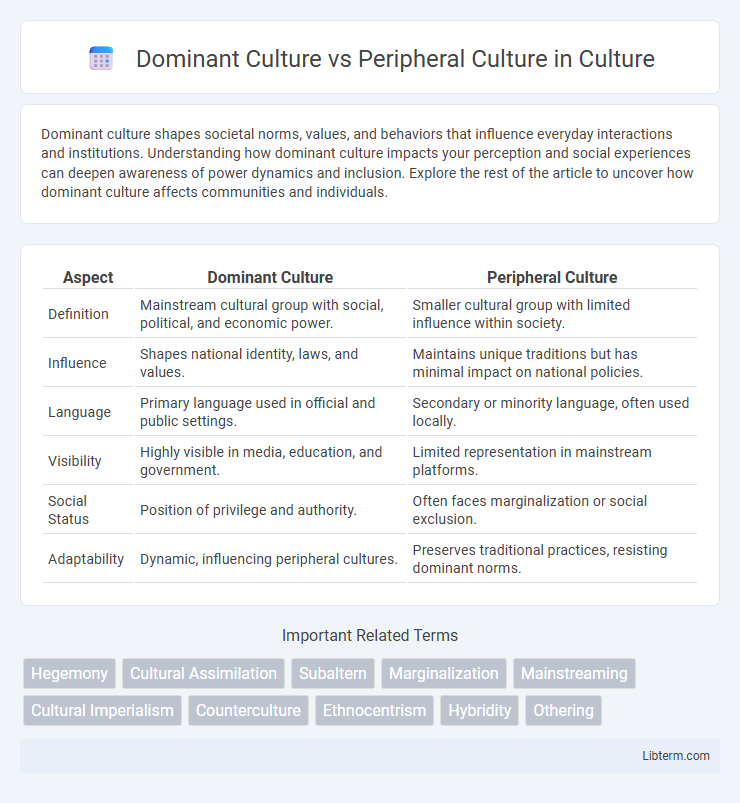Dominant culture shapes societal norms, values, and behaviors that influence everyday interactions and institutions. Understanding how dominant culture impacts your perception and social experiences can deepen awareness of power dynamics and inclusion. Explore the rest of the article to uncover how dominant culture affects communities and individuals.
Table of Comparison
| Aspect | Dominant Culture | Peripheral Culture |
|---|---|---|
| Definition | Mainstream cultural group with social, political, and economic power. | Smaller cultural group with limited influence within society. |
| Influence | Shapes national identity, laws, and values. | Maintains unique traditions but has minimal impact on national policies. |
| Language | Primary language used in official and public settings. | Secondary or minority language, often used locally. |
| Visibility | Highly visible in media, education, and government. | Limited representation in mainstream platforms. |
| Social Status | Position of privilege and authority. | Often faces marginalization or social exclusion. |
| Adaptability | Dynamic, influencing peripheral cultures. | Preserves traditional practices, resisting dominant norms. |
Understanding Dominant Culture: Definition and Characteristics
Dominant culture refers to the set of values, norms, customs, and practices that hold the most influence within a society, shaping political power, social institutions, and mainstream media. Characteristics of dominant culture include widespread acceptance, institutional support, and the ability to define societal standards and identity. Understanding dominant culture involves analyzing its role in maintaining social cohesion and power dynamics, often marginalizing peripheral cultures.
What is Peripheral Culture? Key Traits and Examples
Peripheral culture represents social groups existing outside or on the margins of the dominant culture, often characterized by unique traditions, values, and worldviews that contrast with mainstream norms. Key traits include cultural distinctiveness, limited political or economic power, and occasional social marginalization, with examples being indigenous communities, ethnic minorities, and immigrant enclaves. These peripheral cultures contribute to cultural diversity while facing challenges of integration and preservation within dominant societal frameworks.
Historical Context: How Dominant and Peripheral Cultures Emerge
Dominant culture emerges historically through processes of colonization, conquest, and political power consolidation, establishing norms, values, and institutions that reflect the interests of ruling groups. Peripheral cultures develop concurrently as marginalized or minority groups preserving distinct traditions, languages, and social practices often suppressed or excluded by dominant societies. The historical context reveals power imbalances and cultural resilience shaping these dynamics across various global regions and epochs.
Cultural Hegemony: Influence of Dominant Culture on Society
Cultural hegemony describes the dominance of a ruling class's worldview that becomes the accepted cultural norm, shaping societal values, beliefs, and practices without overt coercion. The dominant culture exerts significant influence by controlling institutions such as education, media, and religion, thereby marginalizing peripheral cultures and limiting their visibility and voice. This power dynamic reinforces social hierarchies and maintains the status quo, often making resistance or alternative cultural expressions difficult to sustain within the broader society.
Marginalization of Peripheral Culture: Causes and Consequences
Marginalization of peripheral cultures often stems from systemic inequalities in political power, economic resources, and social representation imposed by the dominant culture, leading to cultural suppression and diminished visibility. This exclusion results in loss of language, traditions, and identity, exacerbating social alienation and economic disadvantages for marginalized groups. Persistent marginalization can provoke resistance movements and calls for cultural preservation and political recognition, highlighting the critical need for inclusive policies and equitable cultural exchange.
Assimilation vs. Preservation: Cultural Identity Challenges
Dominant culture often pressures peripheral cultures to undergo assimilation, leading to significant challenges in preserving unique cultural identities. Peripheral cultures struggle to maintain their traditional languages, customs, and values while navigating social, political, and economic systems designed by the dominant group. Balancing integration and cultural preservation remains a critical issue in multicultural societies, impacting individual and collective identity continuity.
Power Dynamics: Dominant Culture’s Control in Institutions
The dominant culture exerts substantial power through control of key institutions such as government, education, media, and legal systems, shaping societal norms and values to maintain its supremacy. This control enables the dominant culture to influence policies, enforce cultural standards, and marginalize peripheral cultures by limiting their access to resources and opportunities. Consequently, peripheral cultures often face systemic barriers that inhibit their visibility, representation, and equitable participation in social, economic, and political spheres.
Impact on Language, Art, and Traditions
Dominant culture shapes the primary language, art forms, and traditions widely accepted and promoted within a society, often determining official communication and mainstream artistic expression. Peripheral cultures contribute unique dialects, artistic styles, and customs that enrich cultural diversity but may face marginalization or assimilation pressures. This dynamic influences the preservation of minority languages and traditional practices, affecting cultural identity and heritage continuity.
Strategies for Empowering Peripheral Cultures
Empowering peripheral cultures involves implementing community-driven initiatives that promote cultural preservation and encourage linguistic diversity. Educational programs tailored to include indigenous knowledge systems and local customs enhance cultural pride and resilience against dominant cultural assimilation. Policy reforms supporting equitable resource allocation and media representation ensure peripheral cultures gain visibility and influence within broader societal frameworks.
Towards Cultural Inclusivity: Bridging the Divide
Dominant culture represents the prevailing societal norms, values, and beliefs that shape mainstream identity, while peripheral cultures consist of marginalized or minority groups often excluded from dominant narratives. Bridging the divide requires embracing cultural inclusivity by promoting equitable representation, fostering cross-cultural dialogue, and challenging systemic biases within institutions. Programs prioritizing intercultural competence and community engagement catalyze the transformation toward an inclusive society where diverse cultural expressions coexist and thrive.
Dominant Culture Infographic

 libterm.com
libterm.com